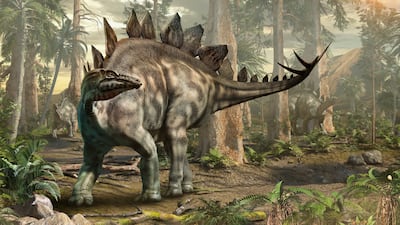A stegosaurus fossil with unique features – including patterned armour and flat spikes on its tail – has been discovered in Morocco's Middle Atlas Mountains.
The species, which lived in the Middle Jurassic period, about 165 million years ago, has been named Thyreosaurus atlasicus, a report in scientific journal Gondwana Research said on Monday.
The stegosaurus is one of the best-known dinosaurs, a four-legged herbivore with a small head, dermal armour – bony plates, popularly depicted as kite-shaped – and a spiky tail.
Thyreosaurus atlasicus was discovered by a team of palaeontologists that included Moroccan researchers from the University of Hassan II in Casablanca and the University of Moulay Ismail in Meknes, plus scientists from Spain, France and Argentina.
The fossil has “remarkable dermal armour” which consists of bony deposits up to 4cm thick, in almost egg-like or rectangular shapes, researchers said.
Its armour is also asymmetric, said researchers, with one side marked by small holes and a fibrous mass, while the other is defined by a distinctive crosshatched pattern, making it “unique among stegosaurs”.
Its tail also sets Thyreosaurus atlasicus apart. While previous stegosaurus discoveries have tail spikes that stand upright, in the Moroccan fossil these appear horizontal.
“It is interpreted that these were arranged in a recumbent position over the body of the animal, instead of an erect position,” researchers said.
These unique characteristics make the discovered dinosaur different from all previous findings, the scientists said in the study.
The fossil is believed to be that of an adult dinosaur, with an estimated length of about six metres. Stegosaurus were usually about six to nine metres long.
The researchers said the fossil, which mainly consists of vertebrae, ribs and dermal armour elements, was excavated in the El Mers III Formation.
The El Mers Group is a group of geologic deposits in the Middle Atlas, ranging from approximately 164 to 168 million years, near the town Boulahfa in the Fes-Meknes region in northern Morocco. It is divided into three formations known as El Mers I, II, and III.
In recent years, Fes-Meknes has attracted the attention of many palaeontologists, after the discovery of two other herbivores, an ankylosaurus named Spicomellus and another stegosaurus, named Adratiklit.
Researchers said the latest discovery will help in understanding the evolutionary history of the Middle Jurassic era in North Africa.
Stegosaurus gets its name from the Greek word for “stegos,” which means roof, and “sauros” meaning lizard. Fossils have been found in locations including the US and China.


